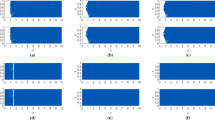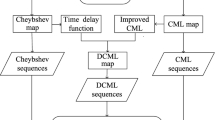Abstract
In this paper, a very low complexity method is proposed to achieve a guaranteed substantial extension in the period of a popular class of chaos-based digital pseudo-random number generators (PRNGs). To this end, the relation between the chaotic PRNG and multiple recursive generators is investigated and some theorems are provided to show that how a simple recursive structure and an additive piecewise-constant perturbation inhibit unpredictable short period trajectories and ensure an a priori known long period for the chaotic PRNG. The statistical performance of the proposed PRNG is evaluated, and the results show that it is a good candidate for applications in which long-period secure pseudo-random sequence generators at a low complexity level are required.


Similar content being viewed by others
Notes
Also called Bernoulli shift or Rényi map.
The period of a recursion modulo \(2^r\) cannot be smaller than its period modulo 2 [36].
Choosing other values for \(a_i\) rather than 1 or 0 does not have any effect on the period length if the feedback polynomial satisfies the conditions of Theorem 1, yet it may change the trajectory.
It is the period of a conventional linear feedback shift register with primitive feedback polynomial.
References
L’Ecuyer, P.: Uniform random number generation. Ann. Oper. Res. 53(1), 77–120 (1994)
Addabbo, T., Fort, A., Rocchi, S., Vignoli, V.: Digitized chaos for pseudo-random number generation in cryptography. In: Kocarev, L., Lian, S. (eds.) Chaos-Based Cryptography, pp. 67–97. Springer, Berlin (2011)
Li, C., Luo, G., Qin, K., Li, C.: An image encryption scheme based on chaotic tent map. Nonlinear Dyn. 87(1), 127–133 (2017)
Mazzini, G.: DS-CDMA systems using q-level m-sequences: coding map theory. IEEE Trans. Commun. 45(10), 1304–1313 (1997)
Addabbo, T., Alioto, M., Fort, A., Pasini, A., Rocchi, S., Vignoli, V.: A class of maximum-period nonlinear congruential generators derived from the rényi chaotic map. IEEE Trans. Circuits Syst. I 54(4), 816–828 (2007)
Jessa, M.: Designing security for number sequences generated by means of the sawtooth chaotic map. IEEE Trans. Circuits Syst. I 53(5), 1140–1150 (2006)
Zhou, Y., Hua, Z., Pun, C.-M., Chen, C.P.: Cascade chaotic system with applications. IEEE Trans. Cybernet. 45(9), 2001–2012 (2015)
Özkaynak, F.: Cryptographically secure random number generator with chaotic additional input. Nonlinear Dyn. 78(3), 2015–2020 (2014)
Deng, Y., Hu, H., Xiong, W., Xiong, N., Liu, L.: Analysis and design of digital chaotic systems with desirable performance via feedback control. IEEE Trans. Syst. Man Cybernet. Syst. 45(8), 1187–1200 (2015)
Öztürk, İ., Kılıç, R.: A novel method for producing pseudo random numbers from differential equation-based chaotic systems. Nonlinear Dyn. 80(3), 1147–1157 (2015)
Cong, L., Xiaofu, W.: Design and realization of an FPGA-based generator for chaotic frequency hopping sequences. IEEE Trans. Circuits Syst. I 48(5), 521–532 (2001)
Murillo-Escobar, M., Cruz-Hernández, C., Cardoza-Avendaño, L., Méndez-Ramírez, R.: A novel pseudorandom number generator based on pseudorandomly enhanced logistic map. Nonlinear Dyn. 87(1), 407–425 (2016)
Wang, Y., Liu, Z., Ma, J., He, H.: A pseudorandom number generator based on piecewise logistic map. Nonlinear Dyn. 83(4), 2373–2391 (2016)
Černák, J.: Digital generators of chaos. Phys. Lett. A 214(3), 151–160 (1996)
Galias, Z.: The dangers of rounding errors for simulations and analysis of nonlinear circuits and systems? And how to avoid them. IEEE Circuits Syst. Mag. 13(3), 35–52 (2013)
Curiac, D.-I., et al.: Chaos-based cryptography: end of the road? In: International Conference on Emerging Security Information, Systems, and Technologies, SecureWare 2007, pp. 71–76 (2007)
Li, C.-Y., Chen, Y.-H., Chang, T.-Y., Deng, L.-Y., To, K.: Period extension and randomness enhancement using high-throughput reseeding-mixing prng. IEEE Trans. Very Large Scale Integr. (VLSI) Syst. 20(2), 385–389 (2012)
Tao, S., Ruli, W., Yixun, Y.: Perturbance-based algorithm to expand cycle length of chaotic key stream. Electron. Lett. 34(9), 873–874 (1998)
Andrecut, M.: Logistic map as a random number generator. Int. J. Mod. Phys. B 12(09), 921–930 (1998)
Li, C., Xie, T., Liu, Q., Cheng, G.: Cryptanalyzing image encryption using chaotic logistic map. Nonlinear Dyn. 78(2), 1545–1551 (2014)
García-Martínez, M., Campos-Cantón, E.: Pseudo-random bit generator based on multi-modal maps. Nonlinear Dyn. 82(4), 2119–2131 (2015)
García-Martínez, M., Ontañón-García, L., Campos-Cantón, E., Čelikovskỳ, S.: Hyperchaotic encryption based on multi-scroll piecewise linear systems. Appl. Math. Comput. 270, 413–424 (2015)
Ontanon-Garcia, L., Jimenez-Lopez, E., Campos-Cantón, E., Basin, M.: A family of hyperchaotic multi-scroll attractors in rn. Appl. Math. Comput. 233, 522–533 (2014)
Tezuka, S.: Uniform Random Numbers: Theory and Practice. Springer, Berlin (2012)
Setti, G., Mazzini, G., Rovatti, R., Callegari, S.: Statistical modeling of discrete-time chaotic processes-basic finite-dimensional tools and applications. Proc. IEEE 90(5), 662–690 (2002)
Lasota, A., Mackey, M.C.: Chaos, Fractals, and Noise: Stochastic Aspects of Dynamics. Springer, Berlin (2013)
Liu, N., Guo, D., Parr, G.: Complexity of chaotic binary sequence and precision of its numerical simulation. Nonlinear Dyn. 67(1), 549–556 (2012)
Werter, M.J.: An improved chaotic digital encoder. IEEE Trans. Circuits Syst. 2 Analog Digit. Signal Process. 45(2), 227–229 (1998)
Kelber, K.: N-dimensional uniform probability distribution in nonlinear autoregressive filter structures. IEEE Trans. Circuits Syst. I 47(9), 1413–1417 (2000)
Penaud, S., Guittard, J., Bouysse, P., Quéré, R.: Dsp implementation of self-synchronized chaotic encoder decoder. Electron. Lett. 36(4), 365–366 (2000)
Park, S.K., Miller, K.W.: Random number generators: good ones are hard to find. Commun. ACM 31(10), 1192–1201 (1988)
Entacher, K.: Bad subsequences of well-known linear congruential pseudorandom number generators. ACM Trans. Model. Comput. Simul. 8(1), 61–70 (1998)
Ripley, B.: Thoughts on pseudorandom number generators. J. Comput. Appl. Math. 31(1), 153–163 (1990)
Engstrom, H.: On sequences defined by linear recurrence relations. Trans. Am. Math. Soc. 33(1), 210–218 (1931)
Barnard, A., Silvester, J., Chambers, W.: Guaranteeing the period of linear recurring sequences (mod 2e). IEE Proc. E Comput. Dig. Tech. 140(5), 243–245 (1993)
Eichenauer-Herrmann, J., Grothe, H., Lehn, J.: On the period length of pseudorandom vector sequences generated by matrix generators. Math. Comput. 52(185), 145–148 (1989)
A statistical test suite for random and pseudorandom number generators for cryptographic applications,NIST special publication 800-22, Rev. 1-a.National Institute of Standards and Technology, Gaithersburg, Maryland, USA (2010)
Lidl, R., Niederreiter, H.: Introduction to Finite Fields and Their Applications. Cambridge University Press, Cambridge (1994)
Acknowledgements
The authors would like to thank Dr. J. Lahtonen for helpful comments on some proofs.
Author information
Authors and Affiliations
Corresponding author
Additional information
This work was supported in part by Iran National Elites Foundation (INEF) and Iran National Science Foundation (INSF).
Rights and permissions
About this article
Cite this article
Dastgheib, M.A., Farhang, M. A digital pseudo-random number generator based on sawtooth chaotic map with a guaranteed enhanced period. Nonlinear Dyn 89, 2957–2966 (2017). https://doi.org/10.1007/s11071-017-3638-3
Received:
Accepted:
Published:
Issue Date:
DOI: https://doi.org/10.1007/s11071-017-3638-3




